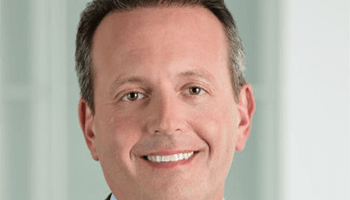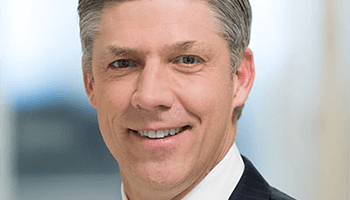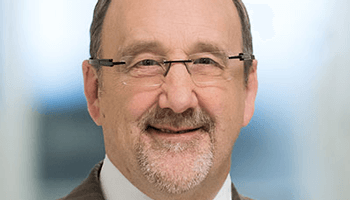
Brent Saunders is Chairman of the Board of Directors, Chief Executive Officer and President of Allergan plc. Bill Meury, Chief Commercial Officer. David Nicholson, Head of Brand R&D.
Brent Saunders is Chairman of the Board of Directors, Chief Executive Officer and President of Allergan plc.

Bill Meury, Chief Commercial Officer.

David Nicholson, Head of Brand R&D.

When we read about Allergan in the news, at the moment it seems to be about all of the deals you’re making. What impact do you think this has on your customers? BS: Interesting, you may be one of the first to ask that question. Frankly that’s the thing that we work the hardest at – customer interaction. We do (and understandably so) get a lot of media attention for the deal-making, but I think the entire management team at Allergan spends, I would say, virtually all their time on managing the business, and for Allergan, what that means is customer intimacy. And so throughout all the deals we have always worked very hard to make sure that we don’t do anything to disrupt the customer relationships and actually do everything to make it a positive enhancement to the customers’ experience. We have surveyed both the core “legacy Allergan” customers – the ophthalmologist or optometrist community as well as the dermatologists and plastic surgeons in the medical aesthetics business – and I think they would almost universally say that their customer experience with Allergan has gotten stronger over the last two years. We have continued to invest: we have just hired another 60 new sales reps in eyecare in the United States, and we’ve added more sales reps in places like Brazil and in China. We’ve added to our medical aesthetics sales support in the United States significantly – it’s almost a third larger this year than it was under the legacy Allergan, and in markets around the world, we continue to invest in in the legacy customer interface. Most importantly is the work that David has done, to bring product flow and innovation to customers, because I think the thing that (universally) every customer cares about the most is: “what’s new?” I think we have led the charge in terms of product flow and innovation in eye care and we continue to make the investments to be able to do that well into the future, by bringing new ideas, new technologies, new drugs, new solutions, new treatment options to physicians – and ultimately patients. WM: I don’t think customer focus is a function of size, and so bigger companies – which Allergan is now – can do it as well or even better than smaller companies. If you did a survey of eye care professionals domestically and internationally, I would say their perception is that we’re making bigger investments and we’re even more focused – and legacy Allergan was terrific at customer focus. But we have more customer focus now than that even 18–24 months ago. And if you look at numbers internally such as turnover and vacancy rates in your customer-facing groups, they’re ultimately charged with carrying the torch for the company. In relative terms there’s a stark contrast between Allergan, despite what’s happened over than 18 months, and the other companies.
At the “coalface”, if you spoke to most ophthalmologists and optometrists, they’d still describe Allergan as an eye drop company. Do you have a vision for where you want to push that that perception of an Allergan within the market? BS: Yes. I think it starts with a bold vision, and where we want to be is number one in eyecare globally. Now that will take time, and to accomplish that, we need to do a lot of things incredibly well. That includes meaningful real innovation coming out of R&D, and includes maintaining and enhancing that customer experience and intimacy. But it also includes offering a full range of solutions for ocular diseases. What we have been doing is moving from just pharmaceutical drop therapy, to implants and drug delivery technologies (like Ozurdex) and also surgical procedures, like with our Xen stent for glaucoma. We’re now starting to just begin to think about diagnostics and other ways to meaningfully participate in in treating these diseases – or perhaps in the future, curing these diseases – in a robust, holistic manner. WM: We have much more than drops in the pipeline. We have the bimatoprost sustained release implant that the pharmaceutical formulation guys did a great job in coming up with – it gives cover for three to four months in glaucoma and will replace the need for these eye drops. We have the TRUTEAR device that has now been submitted to the FDA, and we expect that to launch next year along with the Xen, we have Ozurdex of course which is great in diabetic macular edema. Are we an eyedrop company? Maybe we were... but things are changing dramatically. There is definitely a fine line between being sufficiently diversified and too diversified... but there are sales synergies by having a pharmaceutical, a device, and a procedure. I was on a panel at OIS a couple months ago with Novartis, Alcon, AMO, Bausch + Lomb, and I remember what Bill Link said, which was, “It’s refreshing and reassuring to see that Allergan has such a diverse portfolio. You know that they can actually be a ‘solution’, a single point solution, for customers.” Now that doesn’t mean that we can do everything, and we have to be very careful about new areas and how we acquire the skills and expertise to operate with those new capabilities, but it’s a competitive advantage for Allergan that glaucoma specialists can look to us for many of their solutions. I think that’s down to the culture we have: we’re not dogmatic about what we do, and what we don’t do. Other companies mandate that they are surgical company – and that’s it. Well, innovation doesn’t allow you to be that choosy. If the market is going to go in a certain direction, and if we have a commitment to the customer, then we’re going to figure out how to serve them.
Where do you see the gaps or the opportunities in your portfolio are right now? BS: I think we we’ve done well to build out a robust portfolio of both marketed and pipeline products in areas like dry eye and glaucoma. You know I think, as David said, Ozurdex has done incredibly well in retina and continues to be a strong growth driver, but we need to get deeper into retinal disease. We’ve got a potentially groundbreaking type of treatment in abicipar, which is being studied for AMD and is in Phase III trials at the moment. We’re looking at combination therapies for retinal disease as well. We have a discovery research agreement and partnership with Molecular Partners for a series of binding proteins for the back of the eye. I think in the future that a lot of these significant eye conditions that are genetic could be solved by gene therapy and this may be an area of interest for us in the not-too-distant future.
The ForSight Vision5 acquisition was about sustained delivery platforms. Might abicipar be formulated in a sustained release formulation, as a means of differentiating it from currently more frequently administered wet AMD therapies? BS: To the premise of the question of this, abicipar, which is the lead DARPin compound, is being studied to distinguish itself from current therapy, with one of the arms of the study looking at 12-week dosing, which would substantially lower the injection burden. This is a very invasive drug that has to be delivered through a needle to the back of the eye: doctors don’t like to do it and patients certainly don’t like to receive it, so anything we can do to get really good efficacy and a good risk-benefit profile but reduce that injection burden is would distinguish abicipar in a significant way. WM: My sense is the market bifurcates and then if abicipar is successful, then there’s a premium branded superior product (in abicipar), and then everyone else is going to use a biosimilar of Avastin, leaving the other people in the middle of the tennis court. Now of course, the category is going to evolve in terms of combination therapy but if we’re successful with abicipar, we will look at a combination with an anti-PDGF. But I think Brent’s right, a 12-week dosing regimen on anti-VEGF with a good benefit risk ratio is going to be well received.
It has been fascinating in watching Allergan move so rapidly. What’s your approach to dealmaking? BS: I think that most of the things we do kind of all adhere to a common strategy. One of the first criteria we look at in acquisitions is: is it in our area of expertise, one of our seven therapeutic areas? The second is, is the innovation what highly innovative or a growth-oriented asset? We don’t buy mature or end-of-life businesses and things of that nature. I think from there and then, if we check the boxes, we move very quickly. We are a company that has a bias for action, we think our winning formula is by being great partners and by moving quickly. We are nimble but we adhere to our disciplined strategy. Frankly, we may not always be right, but I’d rather us fail for trying than for watching. I think we’ve got an excellent track record, but there will be a time where we’ve made a bet on something, because it’s science, it might not work. But we will learn from that. We will be very transparent about what assumptions we made that were incorrect or what went wrong, and that will make us a stronger company. So yes, we’re not afraid to go out and get things done.
When you look at the AqueSys deal for Xen, and you look at how close that is to US physicians right now, if the acquisition hadn’t taken place, it simply wouldn’t be a near-term prospect for US physicians. BS: Glaucoma is one of our core three legs of our eyecare franchise, and we have to provide excellent pharmacotherapy and glaucoma drops because that’s our main thing – that’s what we gotta do, we gotta continue looking for new NMEs or innovations in pharmaceutical therapy. But right now the conversation is about MIGS, and so if we didn’t choose to participate and we didn’t take the quick and bold decisive action to buy AqueSys we would be out of the conversation. And by the way, we looked at all the MIGS platforms and as a glaucoma company – as a company so committed to the glaucoma community and specialists – the reason we chose AqueSys simply came down to the fact that it was the most effective MIGS device. We wanted to offer our customers (and ultimately the patients) the most effective option. And that’s how we got there. WM: Internally, we think we should be moving faster! [Laughter] We refuse to be the Kodak of any one of the therapeutic areas that we happen to be involved in, and that can happen very easily. We treat business development as literally a 24/7 job. It’s not something that takes up ten or twenty percent of our time it it’s ingrained and virtually everything we do, because it links right back to what we’re in business to do, which to produce new products for customers.
From Forest, Actavis and Allergan, and on through the acquisition deals that you’ve been doing of late (AqueSys, ForSight Vison5), are there any core lessons that you’ve learned along the way? BS: I’m sure we all have different ones, but for me it’s just to reinforce the value of people, and second to that and closely linked to it is culture. When we go out and buy something or divest something, making sure that that we treat the people exceptionally well, to always stay on the high road, and then to really try to learn from their culture. We bought a small medical aesthetics company, Kythera, maybe 80 employees roughly, and we had 30,000 at the time. We spend weeks trying to learn about their culture and see if there’s something that we should be changing in the 30,000 person company from the 80 person company. We really do take that that stuff seriously and we’ve learned so much from our partners and from the deals we’ve done by just staying open-minded in this continuous quest to be the best at what you do. WM: I would say that one, keep an open mind and two, never underestimate the quality and commitment of people in other companies. When you consolidate three companies you really see that there’s a lot of quality talent and it can be really beneficial when you “own” that. CDN: What really matters is the quality of the people in the company and to make certain that this alignment on culture and goals, and that people buy into what you’re trying to achieve. As Brent’s saying, that’s totally the most important thing, but then when I do think over the last couple of years, we have seen that the approach that we’re following and actually works – when you look at what we’ve added and what you can add in the present day by following the type of open science or acquisition strategy or whatever term you use, it actually works!
So there’s actually a real-world business benefit to taking the high road in these things? BS: I couldn’t say it better myself.
